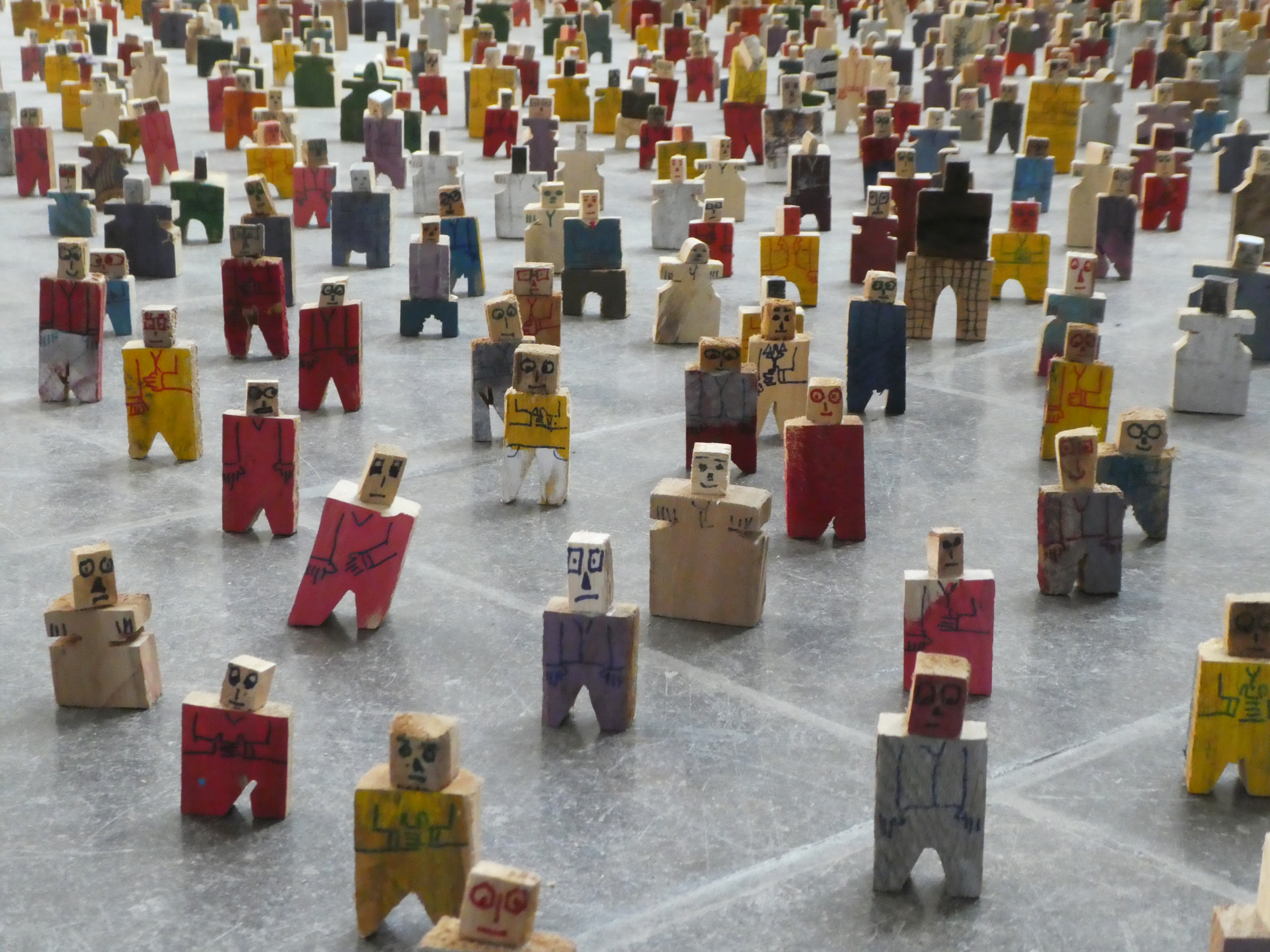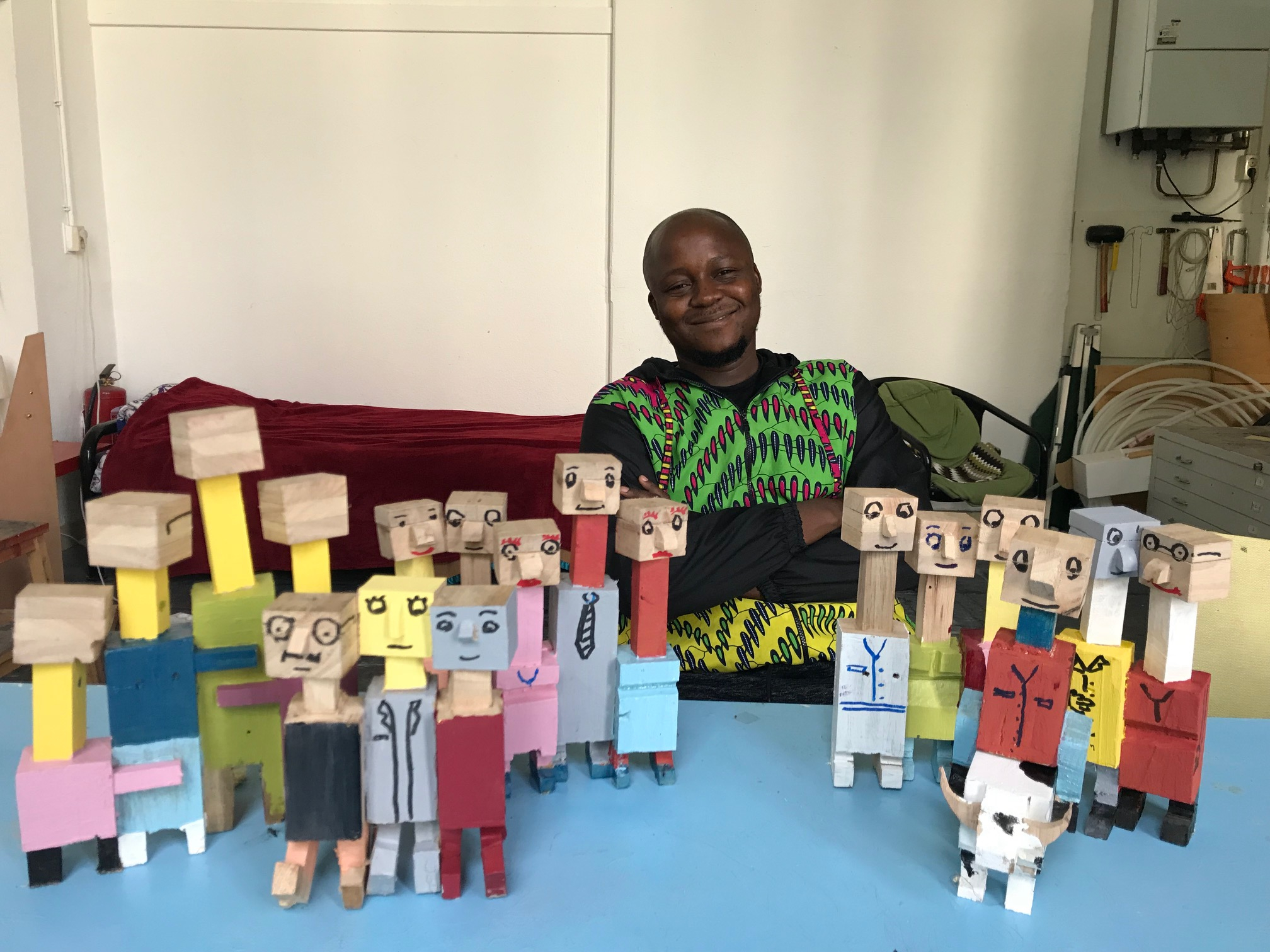The work of Nigerian artist Abdulrazaq Awofeso is the main attraction of the exhibition City Life in the Dutch city of Arnhem. Two thousand small faces to tell you that one shouldn’t generalise.
At nearly 650 years old, it is the oldest church in Arnhem, an important Dutch town near the German border. But the Sint-Walburgiskerk no longer serves as house of prayer. Instead, it is a sanctuary for art. The Arnhem Museum, currently under renovation, makes temporary use of ‘De Kerk’ for its exhibitions. Currently, it houses the vibrant exhibition City Life, eleven artists reflecting on the ‘urban realities’ of the millions of people in cities all over the world.
Africa features prominently in the exhibition. The huge pictures of Kinshasa and Addis Abeba, part of the project Future Cities, immediately draw my attention. The capital of Congo compares itself to Paris, because of the fashion trends it creates and its sapeurs, who self-consciously walk around in their designer jackets. The capital of Ethiopia is shown as the birthplace of new music styles, mysterious and sometimes rousing melodies, come to you through video and audio.
But what catches the eye most is the installation by Nigerian artist Abdulrazaq Awofeso (42). It is spread out over the most prominent part of the building, the choir, where the altar used to stand. Here, on the stone floor, lit by the beams of sunlight that fall through the church windows, stands a silent army of more than two thousand wooden figurines.

The little men and women, about 10 centimetres high and made of painted pallet wood, form an overwhelming, colourful feast for the eyes. From the benches in front of the choir, positioned on the lower church floor, I look at their faces for a long time. Some of them seem happy, some sad, some puzzled: wherever I look, I see something new. Suddenly I realize how wonderfully – though unintentionally – the work fits in with the corona-era: all 2020 figurines keep one and a half meter distance from each other, proportionately speaking.
The title is Gross National Populace, and the work wants to show that behind the Gross National Product, the usual measure for economic growth, ‘there are people, who produce it’, Awofeso says in a phone interview from Lagos. ‘Without the human factor, there is no economy. Each face has got a slightly different expression, because we humans are all different’, he says.
It took three months to create the work, with seven people helping him, he explains. Normally they work as day labourers and have no artistic background. ‘That’s on purpose’, Awofeso says with a laugh, ‘so they’ll do what I tell them, without wanting to change things’.
The curator of City Life, Manon Braat, met Awofeso in 2018, when he was staying in the studio of the Thami Mnyele Foundation in Amsterdam. ‘I was immediately impressed by his work and his personality, his deep humanity, warmth and kindness’, she says. ‘He was already working with figurines at the time, and when I was asked to set up a group exhibition that reflects the times we live in, I thought of his work. I never told him actually, but it was Awofeso's work that gave me the inspiration for the entire exhibition’.
Awofeso, Braat explains, wants everyone to be able to understand his work. ‘Often it is not abstract or conceptual, but more figurative. That is fine with me: he likes to experiment anyway, pushing his boundaries’.
The work in ‘De Kerk’, she describes as ‘unbelievably beautiful, touching and enchanting’. Many visitors agree. ‘A lady told me she came back ten times to look at it, because of her daughter, who could not get enough of it. ‘If I’d go home now, she would hit me’, she said jokingly about her daughter’.
What Braat and Awofeso have in common is a strong connection with South Africa. Braat’s parents live there, and during her visits, she got to know the art scene quite well. ‘It is a strange world, the South African art market’, she says. ‘There is a lot of talent around, but there are just a handful of serious galleries. So, competition is high. The galleries approach new talent, sometimes not older than 22, and offer them contracts that force them to be extremely productive. They throw the artists, often barely out of art school, into the deep end – and not everybody can cope with that’.
Awosefo strongly dislikes seeing people being described as 'illegal'.
Awofeso lived in South Africa for fourteen years, and has experienced xenophobia, violence against foreigners, first hand. He developed a strong dislike of seeing people described as ‘illegal’.
He is also an alumni of the Amsterdam based Thami Mnyele artist residence in Amsterdam. He learned of the life and work of the artist and activist Thami Mnyele, who was killed in 1985 by a South African death squad. The City of Ekurhuleni, east of Johannesburg, formerly known as the East Rand, yearly presents the Thami Mnyele Fine Arts Award. Looking for an artist’s residence on the internet, he found the website of the Thami Mnyele foundation in Amsterdam. After having taken part in the Biennale of Dakar in 2016 with his work, where he met the chair of the foundation, Pauline Burmann, he applied for a stay in the studio.
He enjoyed his time in Amsterdam a lot, he says. He is particularly pleased that the connection remained after his stay. ‘Pauline and others kept in touch with me, from which I benefitted greatly’. Before the opening of City Life, for instance, he spent another week in the foundation’s studio, sharing with the official resident, Adam Belarouchia from Morocco.
Asked if he has something in common with Thami Mnyele, Awofeso doesn’t have to think long. ‘Already in 1993, when I was 15, I took part in a march against what was happening around the elections, which were later annulled by the military. I did it without my parents knowing, because they would have been against it’. Their worries were not unfounded, he says. ‘The police started shooting at the crowd with rubber bullets, and I got a stray bullet in my leg. I had to go to hospital and it took months before it was healed; the bullet hit me very deep’.
But, like Mnyele, his urge to express himself never left him. ‘I like politics; I like to talk about what’s happening in the country. But I do not want it to take over my work. So I put my political comments on Twitter of Facebook, but my Instagram-account I use only for art’.
In Nigeria, ‘there is no real freedom of expression’, Awofeso continues. ‘People I grew up with and who were always very critical about our politicians, started praising the ruling party as soon as they started working for the government’.
Awofeso is less popular in his own country than in Europe, where he has taken part in many exhibitions. Simon Njami, the artistic director of the Biennale in Dakar in 2016, invited him participate in the ‘Afrique Capitales’ exhibition in France in 2017, for example. ‘The Nigerian market struggles to embrace my art’, Awofeso says. But it is not because of his critical ideas, he thinks. ‘The market is quite conservative: the people who buy art like aesthetic works, which they can put on the wall, not installations’.
On the day of our conversation, two thousand Israelis in Tel Aviv demonstrate against Prime Minister Benjamin Netanyahu, positioned a few feet apart. ‘Wow, it looks like a performance of my work’, Awofeso responds when I send him an aerial photo. He immediately posts the picture on his Instagram account.
On his Facebook account, one can see very different things. Little, funny movies, for instance. And a message like ‘The Nigerian masses are currently plagued with 3 types of deadly viruses: corona, hunger and police’. ‘My friends warn me to be careful with my comments’, he says. ‘But I don't care. There should be freedom. Always’.


